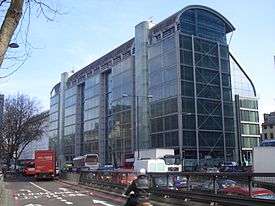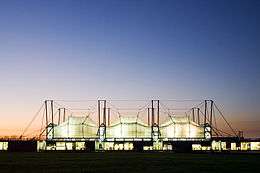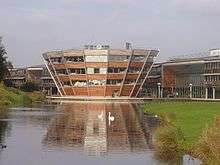Michael Hopkins (architect)
| Sir Michael Hopkins | |
|---|---|
| Born |
7 May 1935 Poole, Dorset, England |
| Education | Sherborne School, Dorset, and Architectural Association |
| Occupation | Architect |
| Spouse(s) | Patty Hopkins |
Sir Michael Hopkins, CBE, RA, AADipl (born 7 May 1935) is an English architect.
Career
Michael Hopkins was born in Poole, Dorset, and educated at Sherborne School[1] and trained at the Architectural Association. He worked for Frederick Gibberd before entering into partnership with Norman Foster, where he was the project architect of the Willis Faber headquarters in Ipswich. With Norman Foster, Richard Rogers and Nicholas Grimshaw, Hopkins was one of the leading figures in the introduction of high-tech architecture into Britain.[2]
In 1976 Hopkins set up what became Hopkins Architects in partnership with his wife, Patricia, who ran her own practice. One of their first buildings was their own house in Hampstead, a lightweight steel structure with glass façades.[3] Early Hopkins buildings, such as the Greene King brewery in Bury St Edmunds and the Schlumberger laboratories near Cambridge, used new materials and construction techniques. The firm challenged conventional architectural wisdom by demonstrating that lightweight steel-and-glass structures could be energy efficient and pioneered the use in Britain of permanent lightweight fabric structures, of which the Mound Stand at Lord's Cricket Ground is a notable example. From the mid-1980s the firm began to explore what Hopkins called the "updating of the traditional materials",[4] adding to the expressive potential of traditional crafts like masonry and carpentry by combining them with contemporary engineering. The practice became recognised for its combination of ultra-modern techniques with traditional architecture, broadening their palette of materials and forms.[2][3]
Together Hopkins and his wife received the Royal Institute of British Architects Royal Gold Medal, awarded in 1994. The citation describes the Hopkins' work as "not only a matter of exploiting technology to build beautifully, nor simply of accommodating difficult and changing tasks in the most elegant way, but above all of capturing in stone and transmitting in bronze the finest aspirations of our age",[3] praising their contribution to the debate about the "delicate relationship between modernity and tradition" and adding: "For Hopkins, progress is no longer a break with the past but rather an act of continuity where he deftly and intelligently integrates traditional elements such as stone and wood, with advanced and environmentally responsible technology."[4]
Michael Hopkins was elected to the Royal Academy in 1992 and awarded the CBE and knighted for services to architecture.[2][3]
Examples of work
Gallery
 Wellcome Trust building on Euston Road, London
Wellcome Trust building on Euston Road, London The Schlumberger Cambridge Research Centre, opened in 1985, was one of Hopkins' earliest buildings and shows his distinctive use of a suspended, high-tech, fabric roof
The Schlumberger Cambridge Research Centre, opened in 1985, was one of Hopkins' earliest buildings and shows his distinctive use of a suspended, high-tech, fabric roof Portcullis House, Westminster, London
Portcullis House, Westminster, London All of the Phase 1 Construction on the University of Nottingham's Jubilee Campus was designed by Hopkins
All of the Phase 1 Construction on the University of Nottingham's Jubilee Campus was designed by Hopkins The Rose Bowl, Southampton, showing the pavilion with the its distinctive fabric roof
The Rose Bowl, Southampton, showing the pavilion with the its distinctive fabric roof
References
- ↑ Some Fascinating and Famous Alumni... , Sherborne School. Retrieved 24 February 2011.
- 1 2 3 Michael Hopkins RA, Royal Academy, 15 July 2007. Retrieved 24 February 2011.
- 1 2 3 4 Glancy, Jonathan. Architects honour husband and wife team, The Independent, 17 February 2004. Retrieved 24 February 2011.
- 1 2 Royal Gold Medal: 1994 Michael and Patricia Hopkins, Royal Institute of British Architects. Retrieved 24 February 2011.
External links
| Wikimedia Commons has media related to Hopkins Architects. |